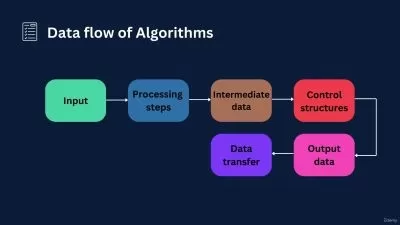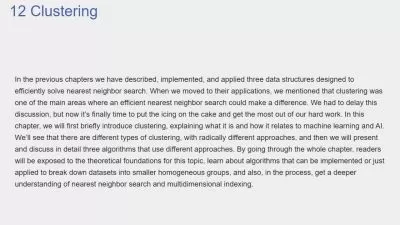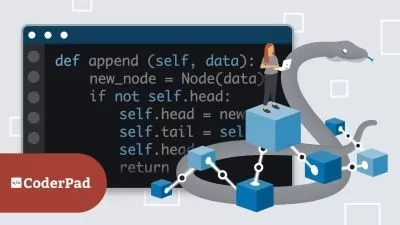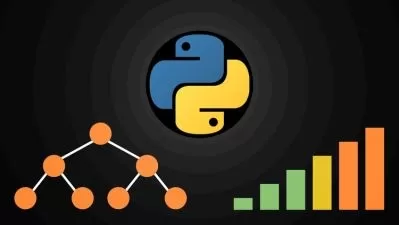Data Structures and Algorithms-Deep Dive into Core Concepts
Dr. P. Saranya Suresh
12:52:00
Description
Mastering the Essentials of Efficient Programming
What You'll Learn?
- Understand the foundational data structures such as arrays, linked lists, stacks, queues, hash tables, graphs and trees,
- Gain a thorough understanding of various sorting and searching algorithms, including quicksort, mergesort, and binary search
- Delve into graph theory and learn essential graph algorithms, including depth-first search (DFS), breadth-first search (BFS), Dijkstra’s algorithm and MST
- Develop strong problem-solving skills by applying data structures and algorithms to real-world scenarios and coding challenges.
Who is this for?
What You Need to Know?
More details
Description"Data Structures and Algorithms: Mastering the Essentials of Efficient Programming" is a meticulously crafted course designed to provide students with a comprehensive understanding of the foundational concepts crucial for proficient coding and problem-solving in software development.
Throughout this course, participants will embark on an enriching journey through a diverse array of topics, immersing themselves in the intricate realm of data structures. From the rudimentary structures like arrays and linked lists to the more complex entities such as stacks, queues, hash tables, trees, graphs, heaps, and balanced trees, every facet is meticulously explored. Through a blend of interactive lectures, engaging discussions, and hands-on exercises, students not only grasp the theoretical underpinnings but also gain practical experience in implementing these structures efficiently.
The curriculum extends beyond mere data structures to encompass algorithmic design principles, equipping students with a diverse toolkit of problem-solving techniques. Furthermore, the course covers a broad spectrum of essential sorting and searching algorithms, empowering students with the ability to tackle diverse computational challenges. Additionally, graph algorithms like depth-first search (DFS), breadth-first search (BFS), and Dijkstra’s algorithm are explored in depth, with a focus on understanding their practical applications in software engineering.
By the culmination of the course, students will emerge equipped with a robust foundation in data structures and algorithms, enabling them to write elegant, scalable code and navigate complex programming tasks with confidence. Whether they are aspiring software engineers seeking to kickstart their careers, seasoned developers aiming to refine their skill set, or individuals preparing for technical interviews or competitive programming competitions, this course caters to a wide spectrum of skill levels and career objectives.
Who this course is for:
- Undergraduate or graduate students studying computer science, software engineering, or related fields who want to deepen their understanding of fundamental algorithms and data structures.
- Individuals with a passion for coding and problem-solving who are eager to explore advanced topics in algorithms and data structures to improve their programming skills.
- Enthusiasts or participants in programming competitions like ACM ICPC, Google Code Jam, or LeetCode who want to sharpen their algorithmic skills and improve their performance in competitive programming.
- Individuals transitioning into careers in tech who want to build a strong foundation in algorithms and data structures to pursue roles in software development or data science.
"Data Structures and Algorithms: Mastering the Essentials of Efficient Programming" is a meticulously crafted course designed to provide students with a comprehensive understanding of the foundational concepts crucial for proficient coding and problem-solving in software development.
Throughout this course, participants will embark on an enriching journey through a diverse array of topics, immersing themselves in the intricate realm of data structures. From the rudimentary structures like arrays and linked lists to the more complex entities such as stacks, queues, hash tables, trees, graphs, heaps, and balanced trees, every facet is meticulously explored. Through a blend of interactive lectures, engaging discussions, and hands-on exercises, students not only grasp the theoretical underpinnings but also gain practical experience in implementing these structures efficiently.
The curriculum extends beyond mere data structures to encompass algorithmic design principles, equipping students with a diverse toolkit of problem-solving techniques. Furthermore, the course covers a broad spectrum of essential sorting and searching algorithms, empowering students with the ability to tackle diverse computational challenges. Additionally, graph algorithms like depth-first search (DFS), breadth-first search (BFS), and Dijkstra’s algorithm are explored in depth, with a focus on understanding their practical applications in software engineering.
By the culmination of the course, students will emerge equipped with a robust foundation in data structures and algorithms, enabling them to write elegant, scalable code and navigate complex programming tasks with confidence. Whether they are aspiring software engineers seeking to kickstart their careers, seasoned developers aiming to refine their skill set, or individuals preparing for technical interviews or competitive programming competitions, this course caters to a wide spectrum of skill levels and career objectives.
Who this course is for:
- Undergraduate or graduate students studying computer science, software engineering, or related fields who want to deepen their understanding of fundamental algorithms and data structures.
- Individuals with a passion for coding and problem-solving who are eager to explore advanced topics in algorithms and data structures to improve their programming skills.
- Enthusiasts or participants in programming competitions like ACM ICPC, Google Code Jam, or LeetCode who want to sharpen their algorithmic skills and improve their performance in competitive programming.
- Individuals transitioning into careers in tech who want to build a strong foundation in algorithms and data structures to pursue roles in software development or data science.
User Reviews
Rating
Dr. P. Saranya Suresh
Instructor's Courses
Udemy
View courses Udemy- language english
- Training sessions 59
- duration 12:52:00
- Release Date 2024/07/26















